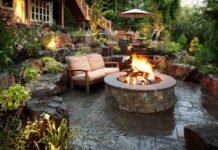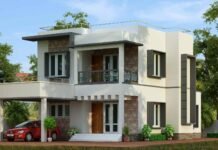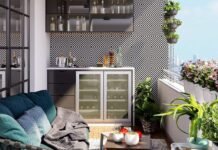Most of us aspire to own a home within walking distance of the ocean. To live near a beach, you’ll want to remain for a long time because you’ll feel so at peace there. Today we have come up with ideas that will boost your exterior designing of house.
It would be wonderful to begin each day with the rising sun’s sight and wave farewell to the setting sun. The nearshore wind will help us feel connected to nature even when working.
In terms of exterior decor design, those fortunate enough to live near the coast must make every effort to make their homes seem their best. Instead, you should put out your best efforts to transform your beachfront property into a tranquil haven.
It’s easy to feel at one with nature if you have an oceanfront-themed façade. Why not let us help you out with this project? We’ve put together the definitive guide to designing gorgeous beach top home design. Then we can be motivated.
Scott Glass, an Architect Who Uses Unfinished Cypress Cladding in His Designs

In addition to a basement, the building has three main volumes on three different levels. You’ll find the main public areas on the middle floor, including the kitchen, dining room, and living room. Privy hedges are treated as living walls, and two-by-three-foot bluestone pavers are used both inside and out (with radiant floor heating in the interiors). A phalanx of sliding glass doors may access sunken patios from the living room. The majority of the house decor design is made of glass, allowing every room to have a panoramic landscape view. It is covered in either fresh cedar or salvaged cypress wood for the rest of the concrete structure.
Quartzite countertops and a huge slab backsplash complement the white-oak cabinetry in the kitchen. Linen floor-to-ceiling curtains are used in all the rooms. The majority of the furnishings are from the mid-to-late 1950s and 1960s.
Maximizing the Topography: Max Nez Arquitectos:

The shape of a cube was cast concrete, and low-iron glass and an aluminum frame were wrapped the outside. In synchrony with the cliff’s terrifying incline, the 3,660-square-foot house rises and falls in tandem. Nez envisioned a series of floors varying in size and ceiling height for the floor plan, some contained in timber-clad boxes that penetrate through the rakishly canted roof plane. The diagonal volume breaks up “the monotony of the open plan” by abandoning hierarchy and order in favor of formal ambiguity and pure sculpture.
ocean is hidden as soon as one enters the spacious foyer, which is located on the building’s highest level. There’s a dramatic change in perspective only after going down the winding staircase with no railing to the glass-enclosed lower-level living room. The red-tinged wood was also used to coat the three-bedroom boxes, inside and out, and the kitchen cabinetry. The arrangement evokes both the dynamism of a Corbusian mansion and the glamour of a Hollywood hillside top home design. The exterior designing of house included a beachy color palette and natural textures, such as linen sofas and wood-trunk side tables.
Modernist Lean-Tos – Designed by Walker Warner Architects and Philpotts Interiors
Beautiful courtyard and walkways and patios unite four distinct structures in a modern interpretation of the early Hale Shelters. Although ancient Hawaiian villages informed the design, the site plan and architectural style were influenced by the clustered nature of many of these communities. Canted steel columns, rhomboidal windows, steep-pitched roofs, and door openings all owe their existence to this design aesthetic.
Warner planned the primary living quarters on the site to face the ocean. Two pods in the back house guest suites and shared restrooms. Beyond the bedrooms, a concrete-walled patio provides further privacy. The leisure room’s walls are covered with custom surfboards displayed as works of art. The design is simple, light, and has a retro vibe. There isn’t an overabundance of furnishings in the rooms. Interiors didn’t need to be overdone because the architecture was so well-considered and had so much natural texture. Earthy, timber-toned furnishings are enlivened with sky-blue rugs and ornate couches in the primary bedroom’s whitewashed wood wall paneling. By design, the indoors and outside are indistinguishable. Sliders and movable windows with Sapele frames swivel open to bring in the fresh air and promote cross-ventilation.
A Montauk House – Brought Back to Life by Lauren Rottet

Some of the hexagonal chambers in the two-story construction are pure, while others are truncated. Even the mode of admission is peculiar. A flying buttress-like bridge connects one side of the house to the driveway. The second-floor kitchen is accessible through this shingle-covered bridge. Behind the front door may find a stair hall/entry gallery/sitting spot with a wall of sliding glass doorways facing the pool. In short it is a beautiful exterior designing of house.
Guest quarters (originally an oil tank workshop) and the family room flank the entryway on either side. Convenient adjacencies rather than corridors connect rooms. The kitchen, primary suite, and living and dining rooms are on the second floor, although a sizeable skylit hallway connects only the living and dining rooms. The floor concept is open and bright, with no dark nooks. New oak flooring was placed at the main bedroom and the downstairs guest room, with the planks laid out in patterns that mirrored the space’s geometry. Any original masonry needed no repairs, including lower story flagstone flooring and large stone fireplaces in the living and family rooms above.
Cabin at the Hamptons – Designed by Harry Bates and Paul Masi:
The structure couldn’t exceed 25 feet in height, but it had to be at least 6 feet above grade. The front yard was filled with sand, and to disguise the septic system planted beach grass and managed rainwater flow. A plinth has been created out of this artificial dune. A gravel road bordered by blackened steel allows visitors to cross it.
The exterior designing of house is cedar-clad, splaying outward as it rises, allowing for a central light and visually expanding the two small bedrooms. The floors and ceilings have been constructed with outstanding leanness—without incorporated ductwork—to increase room heights. It’s an object lesson in designing eco-friendly and modestly for a luxurious living when two independent heat pumps are put flush on the ceilings.
READ NEXT: Ideas to decorate antique and vintage homes
RELATED TOPICS: interior design




